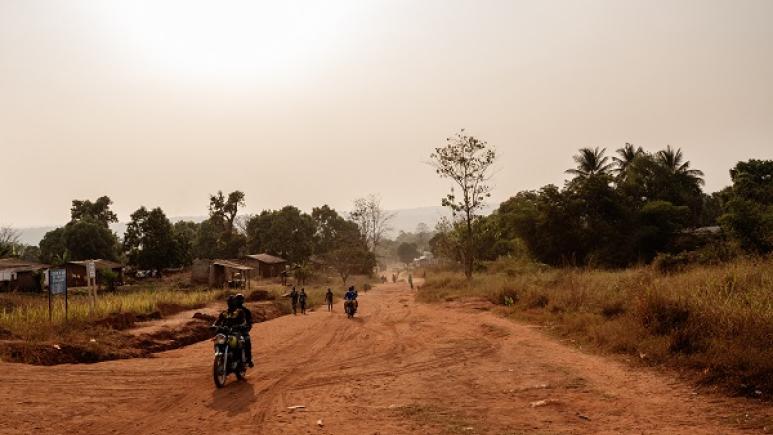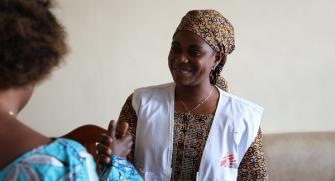Persistent obstacles to HIV care in Carnot, Central African Republic: a brake on progress and access to optimal follow-up
In Carnot, CAR's fourth largest city with a population of around 100,000, following a mortality survey in 2010, MSF expanded its activities to include HIV and TB care at the district hospital. Since 2012, MSF has implemented an integrated model with the Ministry of Public Health, supporting three peripheral health centers, two urban outpatient departments, as well as the paediatric and internal medicine departments of the District Hospital.
"Since monitoring of the cohort of patients living with HIV began in 2011, a very large number of patients have been lost to follow-up, confirming the difficulty of retaining people living with HIV in care in this type of setting. MSF asked us to carry out a study to understand the reasons for this and to describe the factors involved in engagement and disengagement in HIV care," explains Valentina Carnimeo, epidemiologist at Epicentre and principal investigator of the study.
With regard to the evaluation of the programme over the last 10 years, Jihane Ben Farhat, epidemiologist at Epicentre who carried it out, details that more than 5,400 adults have been treated at Carnot since 2011, highlighting the burden of HIV in the district, mainly among women. Despite early initiation of antiretroviral treatment (ART) through the 'Test & Treat' strategy, the cohort recorded significant rates of death (11.3%) and loss to follow-up (35.5%), highlighting and confirming the persistent challenges in the long-term management of HIV.
The study ran from March to July 2023, recruiting over 400 people from patients, carers and key informants who took part in two different parts (quantitative and qualitative) of the study.
Decoding the challenges and lessons of managing HIV care at Carnot
The first finding of the study was that 96% of participants were taking dolutegravir (DTG)-based treatment. In response to the increasing rise in resistance to antiretroviral drugs, in July 2019 the WHO updated its recommendations on first- and second-line treatment, recommending the use of DTG, an integrase inhibitor (INT), combined with two other nucleoside reverse transcriptase inhibitor (NRTI) drugs for all adults, adolescents, infants and children starting antiretroviral treatment. This treatment is also preferred as a second-line treatment for people who have failed treatment and are not taking dolutegravir.
“In line with recent WHO guidelines, new treatment regimens including DTG were introduced in CAR in 2020," explains Valentina Carnimeo. And our results confirm this transition".
On the other hand, almost 12% of individuals are in treatment failure, i.e. with a number of circulating copies of the virus in excess of 1000 copies/ml.
"This result is still acceptable, given the many challenges involved in managing HIV in a rural region such as the Carnot district," points out Valentina Carnimeo.
However, the viral load remains detectable (above 40 copies/ml) in more than a quarter of patients, a long way from the WHO's recommendations of 95% virological suppression, which would probably indicate a lack of adherence to treatment, given the relatively low levels of circulating resistance to NRTIs and Tenofovir.
At every stage of care: obstacles exist
As part of HIV treatment, a number of strategies, including patient-centered approaches, are being implemented to encourage adherence to treatment and patient involvement: Multi-monthly dispensing of ARVs, with the possibility of receiving up to 6 months' treatment in two instalments, creation of community ARV access groups ("CAGs") with one member collecting the entire group's doses of medication for the coming months, thereby reducing transport costs and the time spent on medical consultations, therapeutic education and the search for those lost to follow-up by the association, RECAPEV, of HIV patients. But that doesn't seem to be enough, and very few people take part in the CAG, either because it hasn't yet been offered to them, or because they refuse out of fear for the confidentiality of their illness, as one patient at Carnot explains "This group is good, but [sometimes] some people ... start sharing other members' secrets with others and that's not good, which means I don't want to join this group".
“When we interview patients," notes Pascale Lissouba, epidemiologist at Epicentre, "their involvement in their treatment seems to be influenced by a multitude of interconnected factors.”
First, the distance to be travelled, the costs associated with the journey and safety on the way influence the decision to go to the treatment centre.
In the testimony of a patient from Ndinguiri, she stresses "[When] your treatment is over too, you don't know how to pay for the transport ... Now everything requires money ... sometimes the rebels come out, as well as bad people (robbers) coming out on the way ... they [block our access] to the place of our treatment ... It's not normal, but that's why we're afraid to go [to the clinic] at the moment."
Then, once there, the environment of the care facility, the organization of patient reception, waiting times for services and the perceived quality of care play a crucial role in the commitment of people living with HIV. According to Pascale Lissouba, a major problem raised by respondents is the lack of choice in differentiated approaches to the provision of antiretroviral treatment and waiting times. Although health staff are aware of these problems, they find themselves unable to deal with them effectively:
"The problem is that we are overwhelmed with work... we can't [meet] the needs of our patients... if there are a lot of patients we tell them to wait or come back the next morning, and the next day if they come back but [when we receive] the person who arrived [before them], that becomes a problem.... We need [more] people to help us improve the work."
Food: a priority that eclipses other needs
It would seem important to step up the provision of information to patients so that they understand their treatment better, while at the same time making additional efforts to find and support those who have interrupted their treatment, for example by mobilizing patient associations. However, what stands out the most is the priority need for people living with HIV to eat, which takes precedence over following their treatment, and even jeopardizes taking it.
"I'm told to take my ART in the evening, [but] from morning till night I can't find anything to eat, I even sleep on an empty stomach, sometimes I take my ART without eating, sometimes I'm really hungry, [so] I don't take my ART", said one patient.
Many patients report that they have had to move away from their place of care, interrupting their treatment to find an income-generating activity to support their families.
According to the MSF medical coordinator for the project in Bangui, Dr Jean Buledi Ngoy, "various measures have already been put in place to facilitate access to treatment and improve follow-up for people living with HIV. We are continuing to work with the Ministry of Health to find concrete solutions and continue the fight against HIV at Carnot in CAR.”
Although recent official national data show a reduction in HIV-related prevalence and mortality, there are still gaps in patients' knowledge of their HIV status and access to treatment. Health infrastructures, especially in rural areas, are not sufficiently developed to meet the growing needs of people living with HIV. In addition, limited funding hampers the effectiveness of prevention and treatment programmes. And HIV-related stigma and discrimination remain a major obstacle, discouraging many people from getting tested or seeking care. This atmosphere of exclusion can lead to deep-seated reluctance among patients, as expressed by a patient actively involved in care at Carnot:
"If you only have this disease, that's it for you, they're not going to count you in society any more ... you're already a corpse".













